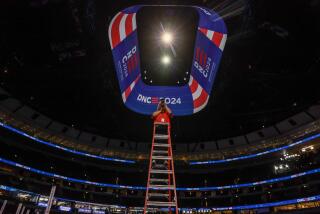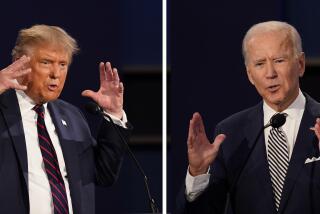‘92 DEMOCRATIC CONVENTION : C-SPAN: The Network That Dares to Be Dull : Television: Covering the Democratic Convention is business as usual at the politically oriented network: No editing, no commercials and no ‘star’ broadcasters.
- Share via
NEW YORK — While the broadcast networks wrestle with hours and ways of covering the Democratic National Convention on prime-time TV this week, C-SPAN, the TV network beloved by policy wonks and congressional-hearings junkies everywhere, will be in its usual element: providing gavel-to-gavel coverage of everything that moves at the podium--and a lot that doesn’t--with no editing, no commercials, no high-priced political commentators and no famous TV anchors.
“Everything that a delegate sees as part of the official proceedings of the convention, we’re going to have on C-SPAN,” said Brian Lamb, the CEO, founder and one of the regular C-SPAN hosts--notice we didn’t say star . Stars are something C-SPAN tries to avoid creating. “At the broadcast networks (which are covering the convention in prime-time with one to two hours per night), the anchors will say, ‘Let’s listen in’ during a speech, then somebody will scream in their ear, saying, ‘This is boring, and we’ve got Diane Sawyer with Sen. Umph; let’s go to her.’ If you wanted to watch the whole speech for yourself, you’ve just lost that opportunity.”
In the MTV age, C-SPAN is TV that dares to be dull. “The broadcast networks,” Lamb said, “have to worry about ‘producing’ the conventions and using their on-air talent and commentators to make the conventions interesting to a mass audience, even though (with the current methods of selecting presidential nominees) there is very little suspense to conventions today. Our self-appointed mission is to cover political events from start to finish, to give viewers the sense of being there themselves and making up their own minds about what’s going on. We never have to decide what we’re going to cover based on how interesting the event is going to be.”
C-SPAN will air the official proceedings (usually beginning at 2 p.m. PDT and ending about 11 p.m. each night; the network also will cover numerous other meetings around the convention during the day. But its coverage will not be limited to the official speeches. There will be viewer call-in shows throughout the day, and, in a technique borrowed from C-SPAN’s new “video verite” campaign-trail program “The Road to the White House,” the network hopes to wire some well-known and little-known participants at the convention (perhaps a senator or a policeman) and follow them around for several hours for a slice-of-life at the convention.
“We’ll be making those plans day-to-day, but, for example, we’ll follow a delegate for the day, take viewers into a caucus meeting, or mike a policeman in Madison Square Garden. We’re also going to have eight mini-cameras in and around New York City, talking to people about what it’s like living in New York City.” Some of the video footage will air on C-SPAN 2, a second C-SPAN channel, while speeches air on C-SPAN, the network’s main channel. “If you’re a political junkie,” Lamb said, “you can have all the fun you want.”
Although Lamb is so impartial on the air that he has been called “Buddha-like” by one media critic, he was surprisingly impassioned when talking about the Washington media scene and the role of the major media during a time of angry populism among voters.
“I’m not a prognosticator, but people seem to be concerned about the economy and their future, and the haves versus the have-nots,” said Lamb, who frequently is the host for C-SPAN’s viewer call-in shows, which gave early exposure to Ross Perot, Bill Clinton, George Bush and all of the other candidates in the presidential campaign.
“An awful lot of people seem to have the impression that some of the haves are in TV, making big money and pontificating about what the world should be about. This is not just Perot followers but Clinton followers and Bush followers too. The politicians are beginning to respond because they have to if they want to get elected, but the media have been slow to respond to this mood of throwing the in’s out.”
Network news, Lamb maintained, has been changed by big salaries. “When people get into the journalism business, they usually get into it because they love information and wanted to impart that. But today, TV news is agents, contracts and salaries. I’m not condemning them because they’re living in the world that was presented to them, but one of the motivations of C-SPAN was to present an alternative. I grew up in a three-network environment, and I always felt there was room for more.”
Lamb, whose salary is said to be lower than that of the average college president, is more likely to been seen taking members of the C-SPAN staff to lunch in a restaurant in the C-SPAN office than having a power lunch or attending the kind of Washington parties where many media and government types schmooze. “I have friends who work in government and in the media, but I don’t go to a lot of parties. I know many journalists feel that they get information that way. But I don’t want to be an insider. I don’t want to know the people I interview any better than our audience.”
C-SPAN--a cable-TV-industry-funded, not-for-profit network that reaches 56 million cable-TV subscribers--has gained a surprisingly wide-ranging audience (ranging, the producers say, from Foggy Bottom-dwellers to Frank Zappa) for its uncut coverage of proceedings in the U.S. Congress, public-policy panels and speeches to organizations like the National Press Club in Washington.
During the presidential campaign, the network has been praised for its extensive coverage of the campaign, particularly “The Road to the White House.” The twice-weekly, 90-minute series, which will continue until the November election, basically mikes the candidates and follows them on the campaign trail, giving them enough cable wire to reveal themselves--or hang themselves. (Although C-SPAN elected not to broadcast the remarks because the candidate did not know he was being recorded, it was a C-SPAN crew that captured Sen. Bob Kerry’s off-color joke about a lesbian.)
Lamb, who said that he has never registered as a member of any political party, worked in government jobs in both the Lyndon Johnson and Richard Nixon administrations. He learned about the emerging world of cable technology as a staffer in Nixon’s telecommunications office. Later, as Washington bureau chief for a cable-TV trade journal, he presented the cable-TV industry with the idea of funding a cable network. C-SPAN, which went on the air in 1979, has been expanding its coverage steadily, doubling its budget for election coverage from $1 million in 1988 to $2 million in 1992.
“When I was in the Navy during the 1960s,” Lamb recalled, “I used to put on a pair of jeans and go down to see the protests against the Vietnam War, just to see what was going on. Watching the coverage at night on TV, I was always struck by how much was missing from the event in what would get picked up for the few minutes on the evening news. The whole idea of C-SPAN is to give viewers the full event as completely as possible.”
Convention Coverage
Here is today’s television schedule of the opening of the Democratic National Convention in New York.
Today’s agenda will included scheduled keynote addresses by Sen. Bill Bradley (D-N.J.), Georgia Gov. Zell Miller and former Texas representative Barbara Jordon.
All times Pacific Daylight.
TELEVISION
CBS (2 and 8), 6:30 to 8 p.m.
NBC (4, 36 and 39), 7 to 8 p.m.
ABC (7, 3, 10 and 42), 6:30 to 8 p.m.
PBS (28 and 15), 5 to 8 p.m.
CNN (cable), 3 to 8:30 p.m.
C-SPAN (cable) 2 to 8:30 p.m.
KMEX (34), 10-11 p.m.
RADIO
KCRW-FM (89.9), in cooperation with National Public Radio, plans extensive live coverage throughout the day.
TUESDAY: Platform presentations and scheduled remarks by Texas Gov. Ann Richards and California U.S. Senate candidate Dianne Feinstein.
More to Read
Get the L.A. Times Politics newsletter
Deeply reported insights into legislation, politics and policy from Sacramento, Washington and beyond. In your inbox twice per week.
You may occasionally receive promotional content from the Los Angeles Times.









